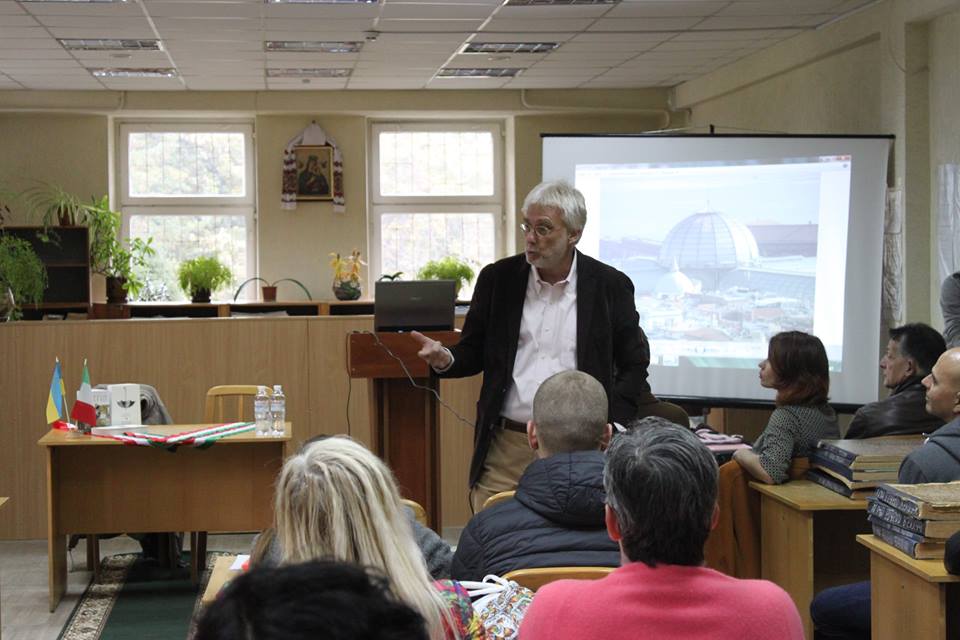
On October 20, 2017, as part of the 17th Week of the Italian Language (under the high patronage of the President of the Italian Republic), a presentation of the modern Italian writer Silvio Perrella’s works took place at the Scientific Library.
The writer shared his ideas about architecture of an Italian city, combining the philosophy of existence with the architectonics of a verbal text. The writer started his presentation with his reflections on a dome and crypt of a Neapolitan gallery. There is a temple near the gallery, so their combination creates a certain dialogue. The vault becomes a harbor for the echo of voices – a discourse of everything that has ever been said, interwoven phrases and sounds hovering over the city. The sea on the background of Naples seems to be simultaneously a silent and stormy observer, it encapsulates time that flies…
Architecture and fiction. Statics and dynamics. According to Silvio Perrella, the outlines of stone buildings resemble the art of the written word, every detail of an architectural masterpiece finds an echo in words.
Stairs appear to be an extremely bright and symbolic detail in buildings – for someone they mean moving upwards, towards oneself or aspiration to the Absolute, and for others they mean moving downwards, immersing in time. Stairs is a choice of direction and priorities. When choosing stairs, people have to move, they are destined to climb the stairs they have chosen … even if it means going round in circles. The stairs of the gallery are made of volcanic rock since Vesuvius is located nearby. The name of the architect is unknown. However, the writer considers these stairs to be an echo of ancient Babylon. Babylon no longer exists, but Naples does!
The magnificent buildings of the ancient city resemble ships in a blue sea. They dock or embark on a long voyage, which is a symbol of statics and, at the same time, continuance in time. Even the rock that was used for the construction of the magnificent city represents two kinds of discourse: limestone for Silvio Perrella is associated with Homer, and tuff – with Virgil.
Time embodied in the sundial on the facade of the hospital hovers over the city, in fact, it is Tempo vero (exact time or real time). And people who pass by and do not notice it; however, when they lift their eyes, they understand that the inscription says something really important. Is time, which for the universe is only a product of human imagination and human conventions, real? People measure time which they do not possess. “We rarely lift our eyes not only to look at a tree in the city, but also at the words carved in stone. We do not notice them. Having noticed them, we do not hear these words. Between us and the antiquity there is not only the time or space abyss, but an abyss we cannot overcome – the abyss of silence,” claims the contemporary Ukrainian writer Andriy Sodomora. Two visions immersed in antiquity. Thus the second clock on the wall of Naples cathedral resembles a secret cipher – the parts of the clock make it look like hands that are reaching out with the intention of revealing a secret – as if the city was giving us a hand, according to Silvio Perrella.
The shutters of the buildings look like human eyes … The writer is very fond of taking photographs (the discussion centered on the book by Silvio Perrella entitled “Doppio scatto”, which means “double click”). Although he is not a professional photographer, the writer’s outlook can be traced in his photographs – a view through a lens as if a view through a window, where the world unfolds its horizons in two clicks: the first – through a camera lens, and the second is the writer’s reception. The writer enters into a dialogue with Naples on the basis of his own photographs which capture the moments of existence in the city and the existence of the city. A view through the prism of silence, when you can contemplate, being detached from the world.
Thus we recommend you to immerse yourselves in the words carved from stone, and with the help of a melodic and beautiful Italian language to find your hidden stairs in Silvio Perrella’s books.